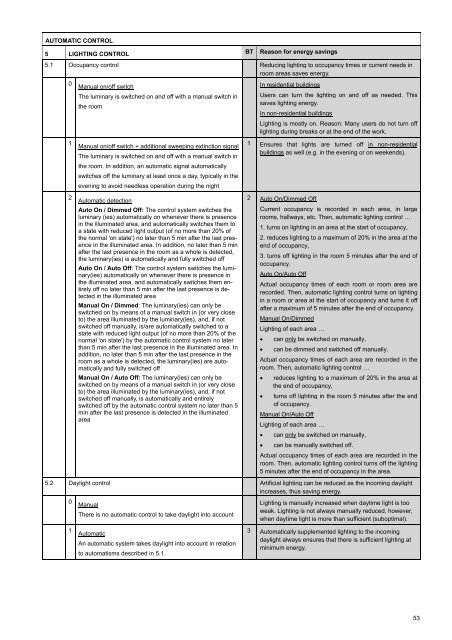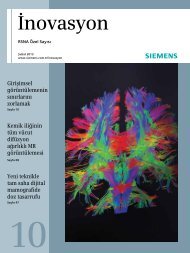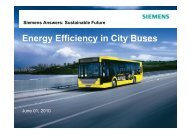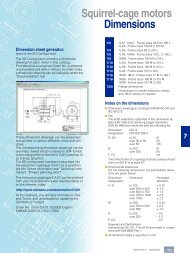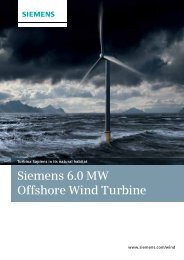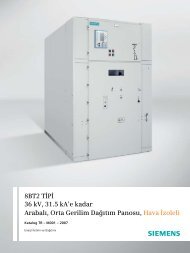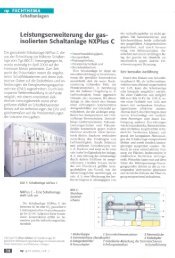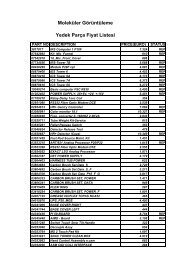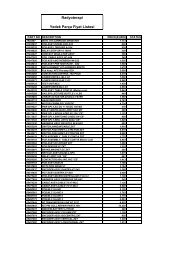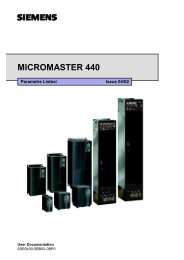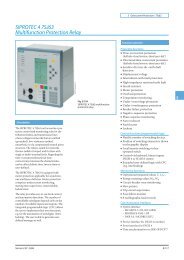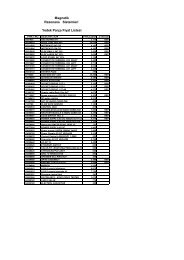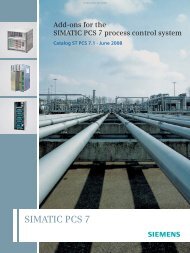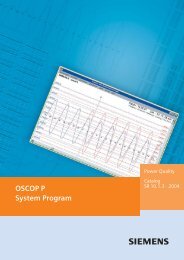Building automation â impact on energy efficiency - Siemens ...
Building automation â impact on energy efficiency - Siemens ...
Building automation â impact on energy efficiency - Siemens ...
You also want an ePaper? Increase the reach of your titles
YUMPU automatically turns print PDFs into web optimized ePapers that Google loves.
AUTOMATIC CONTROL<br />
5 LIGHTING CONTROL BT Reas<strong>on</strong> for <strong>energy</strong> savings<br />
5.1 Occupancy c<strong>on</strong>trol Reducing lighting to occupancy times or current needs in<br />
room areas saves <strong>energy</strong>.<br />
0<br />
Manual <strong>on</strong>/off switch<br />
The luminary is switched <strong>on</strong> and off with a manual switch in<br />
the room<br />
In residential buildings<br />
Users can turn the lighting <strong>on</strong> and off as needed. This<br />
saves lighting <strong>energy</strong>.<br />
In n<strong>on</strong>-residential buildings<br />
Lighting is mostly <strong>on</strong>. Reas<strong>on</strong>: Many users do not turn off<br />
lighting during breaks or at the end of the work.<br />
1<br />
2<br />
Manual <strong>on</strong>/off switch + additi<strong>on</strong>al sweeping extincti<strong>on</strong> signal<br />
The luminary is switched <strong>on</strong> and off with a manual switch in<br />
the room. In additi<strong>on</strong>, an automatic signal automatically<br />
switches off the luminary at least <strong>on</strong>ce a day, typically in the<br />
evening to avoid needless operati<strong>on</strong> during the night<br />
Automatic detecti<strong>on</strong><br />
Auto On / Dimmed Off: The c<strong>on</strong>trol system switches the<br />
luminary (ies) automatically <strong>on</strong> whenever there is presence<br />
in the illuminated area, and automatically switches them to<br />
a state with reduced light output (of no more than 20% of<br />
the normal '<strong>on</strong> state') no later than 5 min after the last presence<br />
in the illuminated area. In additi<strong>on</strong>, no later than 5 min<br />
after the last presence in the room as a whole is detected,<br />
the luminary(ies) is automatically and fully switched off<br />
Auto On / Auto Off: The c<strong>on</strong>trol system switches the luminary(ies)<br />
automatically <strong>on</strong> whenever there is presence in<br />
the illuminated area, and automatically switches them entirely<br />
off no later than 5 min after the last presence is detected<br />
in the illuminated area<br />
Manual On / Dimmed: The luminary(ies) can <strong>on</strong>ly be<br />
switched <strong>on</strong> by means of a manual switch in (or very close<br />
to) the area illuminated by the luminary(ies), and, if not<br />
switched off manually, is/are automatically switched to a<br />
state with reduced light output (of no more than 20% of the<br />
normal '<strong>on</strong> state') by the automatic c<strong>on</strong>trol system no later<br />
than 5 min after the last presence in the illuminated area. In<br />
additi<strong>on</strong>, no later than 5 min after the last presence in the<br />
room as a whole is detected, the luminary(ies) are automatically<br />
and fully switched off<br />
Manual On / Auto Off: The luminary(ies) can <strong>on</strong>ly be<br />
switched <strong>on</strong> by means of a manual switch in (or very close<br />
to) the area illuminated by the luminary(ies), and, if not<br />
switched off manually, is automatically and entirely<br />
switched off by the automatic c<strong>on</strong>trol system no later than 5<br />
min after the last presence is detected in the illuminated<br />
area<br />
1 Ensures that lights are turned off in n<strong>on</strong>-residential<br />
buildings as well (e.g. in the evening or <strong>on</strong> weekends).<br />
2 Auto On/Dimmed Off<br />
Current occupancy is recorded in each area, in large<br />
rooms, hallways, etc. Then, automatic lighting c<strong>on</strong>trol …<br />
1. turns <strong>on</strong> lighting in an area at the start of occupancy,<br />
2. reduces lighting to a maximum of 20% in the area at the<br />
end of occupancy,<br />
3. turns off lighting in the room 5 minutes after the end of<br />
occupancy.<br />
Auto On/Auto Off<br />
Actual occupancy times of each room or room area are<br />
recorded. Then, automatic lighting c<strong>on</strong>trol turns <strong>on</strong> lighting<br />
in a room or area at the start of occupancy and turns it off<br />
after a maximum of 5 minutes after the end of occupancy.<br />
Manual On/Dimmed<br />
Lighting of each area …<br />
• can <strong>on</strong>ly be switched <strong>on</strong> manually,<br />
• can be dimmed and switched off manually.<br />
Actual occupancy times of each area are recorded in the<br />
room. Then, automatic lighting c<strong>on</strong>trol …<br />
• reduces lighting to a maximum of 20% in the area at<br />
the end of occupancy,<br />
• turns off lighting in the room 5 minutes after the end<br />
of occupancy.<br />
Manual On/Auto Off<br />
Lighting of each area …<br />
• can <strong>on</strong>ly be switched <strong>on</strong> manually,<br />
• can be manually switched off.<br />
Actual occupancy times of each area are recorded in the<br />
room. Then, automatic lighting c<strong>on</strong>trol turns off the lighting<br />
5 minutes after the end of occupancy in the area.<br />
5.2 Daylight c<strong>on</strong>trol Artificial lighting can be reduced as the incoming daylight<br />
increases, thus saving <strong>energy</strong>.<br />
0<br />
Manual<br />
There is no automatic c<strong>on</strong>trol to take daylight into account<br />
Lighting is manually increased when daytime light is too<br />
weak. Lighting is not always manually reduced, however,<br />
when daytime light is more than sufficient (suboptimal).<br />
1<br />
Automatic<br />
An automatic system takes daylight into account in relati<strong>on</strong><br />
to automatisms described in 5.1.<br />
3 Automatically supplemented lighting to the incoming<br />
daylight always ensures that there is sufficient lighting at<br />
minimum <strong>energy</strong>.<br />
53


